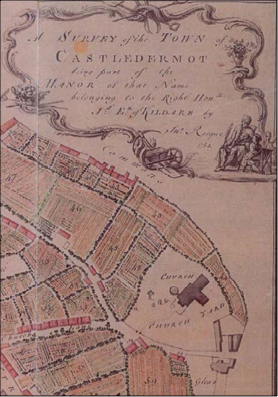
This page highlights the North Cross at Castledermot, in County Kildare. It includes an Introduction to the Site, and a description of the Images on each face of the cross. page highlights the South Cross at Castledermot, in County Kildare.
The Site: The history of the south cross is a bit mysterious. An estate map of Castledermot was commissioned by the Earl of Kildare and created in 1758 by John Rocque, a noted surveyor and cartographer. This map (see a small section to the left) shows the church yard. In the yard one cross is visible, the North Cross. (Harte and Richardson, p. 8 & figure 4) This suggests the south cross was not standing in the mid-eighteenth century. Peter Harbison supports this implication when he reports that three pieces of the cross were re-assembled in the 19th century under the direction of the Marquis of Kildare. (Harbison, 1992, 39) In the photo below it appears the three peices were the base, the shaft and the head.
Like the north cross, the south cross is made of granite. The cross stands about eight feet nine inches tall. It is a little over three feet wide across the arms. It sits atop a base that is just over two feet tall. There are a number of scenes on the south cross that duplicate images found on the north cross as will be noted below.
East Face: The Base on the east face of the cross has no decoration, as can be seen in the photo of the east face of the cross (below right).
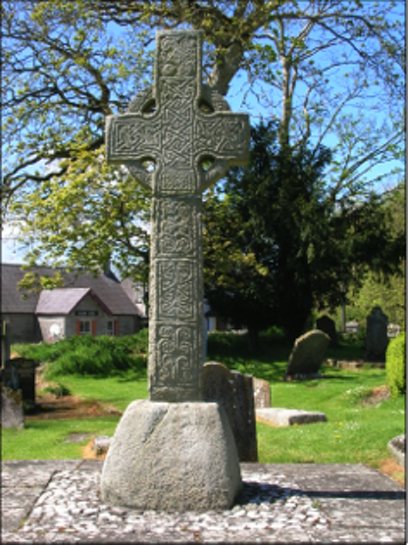
The Shaft and Head of the east face are completely covered by geometric design. The shaft has four panels. Moving up the shaft we have C-shaped spirals, a fretwork pattern, a panel of S-spirals and a small panel of interlace.
The head and arms are decorated with fret patterns. Those in the center of the head run vertically while those on the arms run horizontally.
The Top has a spiral in each corner. They arise from an undecorated central diamond shaped surface.
The Ring is decorated with S-spirals.
The features of the head, arms and ring are more clearly seen in the image below.
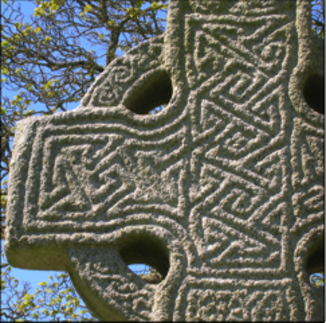
South Face:
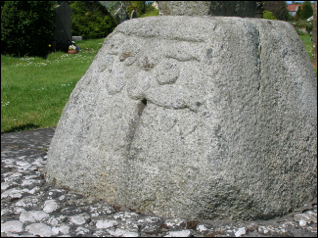
The Base is decorated with an image of the multiplication of the loaves and fishes. The story is told in the Gospel of Matthew 15:32-38 and in the Gospel of Mark 8::1-10. A similar image appears on the base of the north cross, the south face. Like that image Jesus is to the left reaching out to bless loaves and fish. In this case there are five loaves and two fish. An addition here is the presence of eight figures on the lower part of the scene. They probably represent those who had come out to hear Jesus teach and were in need of food.
The Shaft has six panels (see below left and center). Each depicts two figures viewed frontally. Because the total number of figures is twelve, it is assuned they represent the Apostles. The Apostles also appear on the north cross. There the figures surround the head of the cross on the east face.
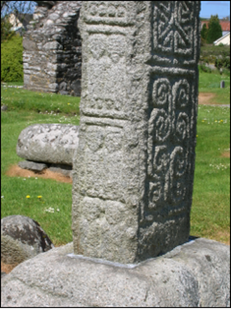

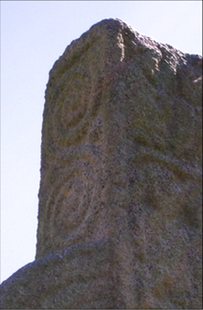
While not shown, the under side of the ring has a sunken panel and the end of the arm has a figure that has not been identified. The top (above right) has an S-Spiral pattern. (Harbison, 1992, p. 39)
West Face: The west face of the cross (below left) contains an eclectic collection of scenes including images from the Hebrew Scriptures, the Christian scriptures and stories of the early desert fathers.

The scene on the base has been interpreted in two different ways. Many high cross scholars have interpreted the scene (below) as Noah herding the animals into the ark. This is part of the story of the great flood told in chapters 7-9 of the book of Genesis. The implication is that Noah and perhaps one of his sons are driving animals toward the ark just before the beginning of the flood. The challenge to this interpretation is that there are no pairs of animals and the herders are seen to carry weapons.
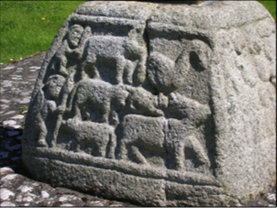
Peter Harbison suggests this is a depiction of a hunting scene. (Harbison, 1992, p. 39) There are similar scenes on two other high crosses: the Market cross and the South cross at Kells. In each case the image may be interpreted either as a hunt scene or as relating to Noah driving the animals into the ark. Thus comparison does not help to identify the intended content.
There are four other crosses that have images that reference the flood story. They are the Armagh Market cross, the Donaghmore cross in County Down, the West cross at Kells and the West cross at Killary. In each of these cases it is an image of the ark itself that is depicted.
The Shaft of the cross contains four images as seen below. The lowest image (below left) depicts Daniel in the Lion's Den. While not sharp and clear Daniel can be seen in the center of the image with two lions depicted vertically on each side. We see almost exactly the same image on the west face of the North cross.
The next image (below right) has been interpreted by Peter Harbison and others to represent the temptation of Saint Anthony. Others have suggested it represents temptation (but not of Saint Anthony), the temptation of Suzanna, or the Arrest of Christ. (Harbison, 1992, p. 39) Again we have an almost exact image on the North cross. There I have interpreted it as representing the temptation of Suzanna. The story of Suzanna is told in the previous feature. The image almost certainly is indended to depict temptation because the two side figures have human bodies but animal heads. My interpretation would mean the lowest two images here both represent stories from the book of Daniel.
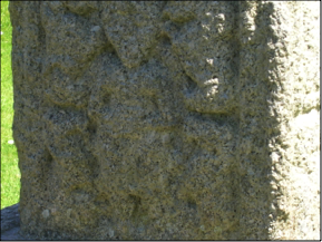

There is no doubt about the indentification of the next panel (below left). It clearly depicts the story of Eve giving the apple to Adam. This image can also be found on the North cross. There it occupies the center of the head on the west face which allows for the branches and fruit of the tree to come down behind Adam and Eve. In both cases Eve is seen in the act of handing over the forbidden fruit.
The top image on the shaft of the cross (below right) clearly represents the story of Saints Paul and Anthony sharing bread in the desert. Once again this image is a duplication of a similar image on the North cross. The story is told in the previous feature.
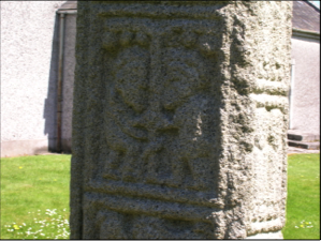
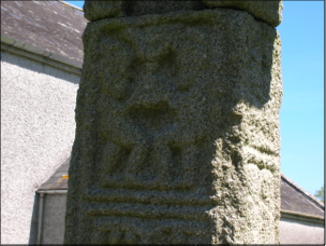
The Head of the cross has six separate images, two of which are difficult to clearly interprete.
Mocking or Flagellation of Christ is one interpretation of the scene at the top of the west face. While it is difficult to see clearly in the photo below, Peter Harbison describes it as follows: "A central figure, shown frontally, is flanked on each side by a figure in profile. Each of the flanking figures holds up a sword (or a club?). . . the wing-like side-appendages of the central figure being perhaps the scarlet or purple cloak which the soldiers put on Christ." Other interpretations suggest this image depicts Moses, Aaron and Hur, the Arrest of Saint Peter or the Massacre of the innocents. (Harbison, 1992, p. 40)
Unidentified is the way Peter Harbison describes the second panel down. There are three figures facing forward but the lack of attributes make it impossible to clearly identify. Of course suggestions have been made including the Journey to Emmaus, the Fiery Furnace and the Three Wise Men delivered from Herod. (Harbison, 1992, p. 40)
The left arm contains an image of David playing the harp. David sits with the harp on his lap. The right arm depicts the Sacrifice of Isaac. Abraham on the left carries a sword. Isaac bends over an alter at the lower right and the ram is pictured in the upper right.
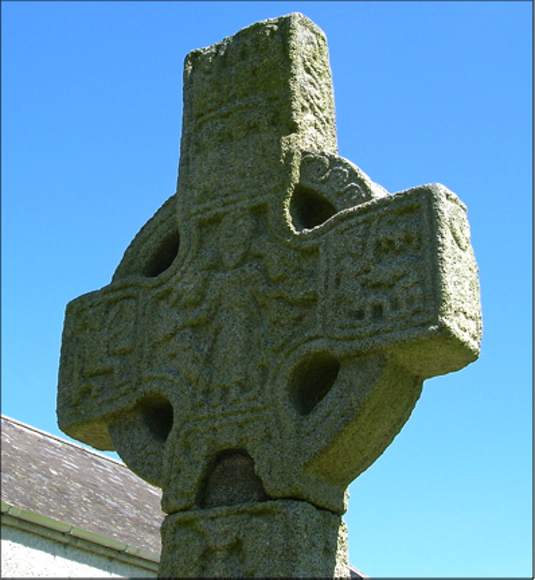
The Crucifixion fills the center of the head of the cross. The scene contains all the typical elements. Christ wears a long robe, Stephaton on the right offers vinegar while Longinus on the left thrusts a spear into Christ's side. Above Christ's arms angels fly toward his head. Following the pattern of the crucifixion scene on the north cross, Christ's arms seem to extend out from the elbows in an awkward pose.
The panel at the bottom of the head is damaged. There are three figures but no identifying attributes.
North Face: I don't have a photo that adequately shows the details of the north face. The image below does not render any detail, even when enlarged. What follows is Peter Harbison's identification of the various panels. (Harbison, 1992, pp. 40-41)
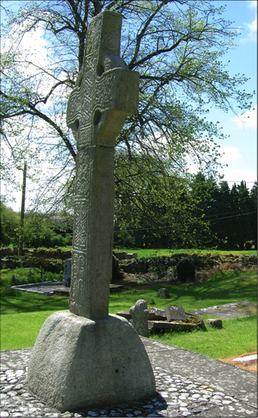
The base has an image identified as the Kiss of Judas on the right half of the base. The area on the left side of the base is left uncarved.
Harbison identifies most of the images on the shaft as part of the David cycle, images reflecting the life of King David. He suggests we read them from the top down.
Unidentified: This panel depicts two figures in profile. They seem to be embracing, though some have identified the scene as Jacob wrestling the Angel. Options related to the David cycle might include David embracing Absalom or Johathan, Samuel kissing Saul, or Saul loving David greatly.
David Arming Himself: The one figure in this tableau holds a round shield in the left hand and a sword in the right. Other interpretations include the Evangelist Matthew, The Massacre of the Innocents, or simply a chief or warrior.
David and Goliath: In an elongated panel there are two figures. The one on the right is large and holds a sword. The figure on the left is of smaller stature. Other interpretations include the Apostle Matthew and his angel and the Massacre of the Innocents.
David Slays Goliath: A large seated figure on the right has a much smaller figure sitting on his raised right leg. This figure looks back toward a sword. This would fit the moments before David beheaded the already defeated Goliath. Once again some interprete this as a scene from the Massacre of the Innocents. Other, less likely identifications include Aeneas escaping from Troy, the dwarf Cnu Deireoil singing to Finn and a Prophet and Evangelist.
David rejoicing or praying: One figure stands frontally with arms raised in a pose like the orans or prayer posture.
The Under Side of the Ring has a sunken panel that is undecorated.
The End of the Arm shows a single figure. No identification is made by Harbison.
The Top contains an S-spiral.
References cited:
Harbison, Peter; The High Crosses of Ireland: An Iconographical and Photographic Survey, Dr. Rudolf Habelt GMBH, Bonn, 1992. Volume 1: Text, Volume 2: Photographic Survey; Volume 3: Illustrations of Comparative Iconography.
Harte, Aidan and Richardson, Aine,"Archaeological Excavation Report 04E0750 - Castledermot town, Co. Kildare" Eachtra Journal, Issue 7, August 2010.